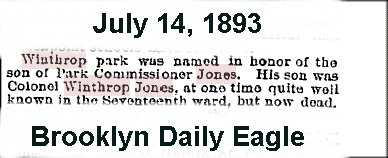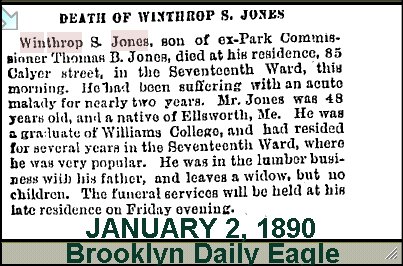
More On Winthrop Park:
Conflicting information on the name of the park:
BROOKLYN DAILY EAGLE ARCHIVES:


NYC.GOV WEBSITE
MONSIGNOR McGOLRICK PARK
9.13 acres Courtesy: http://nycgovparks.org
In 1889 the City of Brooklyn acquired the land for a park on a site bounded by Monitor and Russell Streets, Nassau and Driggs Avenues. Winthrop Park was named for Assemblyman Winthrop Jones, who was instrumental in obtaining the $132,825 appropriation for the purchase. A lifelong resident of Greenpoint, Jones co-owned a lumberyard at the corner of Kent and West Streets and also worked as a job printer.
Improvements to the park were underway by 1891. The site was graded and fitted with a drainage system, and a new lawn was planted. By the end of the decade, Winthrop Park featured paved walks, new trees, shrubs, a shelter building, iron fences, and a novelty in recreation--boxes filled with "sea sand" in which children could play. On Saturdays during the summer, neighborhood residents gathered in the park to hear band concerts. A playground was created in the park in 1897. A handsome shelter pavilion was erected in the park in 1910. Designed by the architectural firm of Helmle and Huberty, the curved building of brick and limestone features an elegant wood colonnade. It is listed on the National Register and recognized as a New York City landmark. In 1985 the shelter pavilion underwent an $850,900 rehabilitation that provided a new roof, repairs to the walkway, graffiti removal, reconstruction of the colonnade, and replacement of windows and doors.
The park's two monuments were also restored in 1985. The World War I memorial (1923) to the south of the shelter pavilion was designed by Carl Augustus Heber. It honors 150 Greenpoint soldiers who fought in World War I. The Monitor and the Merrimac (1939) by sculptor Antonio de Filippo, celebrates the battle of the ironclad USS Monitor and Confederate Merrimac on March 9, 1862 off the coast of Hampton Roads, Virginia. Designed by Swedish engineer John Ericcson, the Monitor was built at the Continental Iron Works in Greenpoint and outfitted at the Brooklyn Navy Yard.
In 1941 the park was renamed for Monsignor Edward J. McGolrick (1857-1938), who hailed from Dunnoughmore, County Donegal, Ireland. In 1888 Father McGolrick joined the parish of St. Cecilia's, and for fifty years he served as pastor. He was instrumental in the creation of a new church, convent, rectory, hospital, lyceum, school, and playing field. Greenpointers remember Monsignor McGolrick as a leader in the parish and in the community.
Monsignor McGolrick Park was the site of a massive 5x5 spruce-up campaign in 1987. Parks employees removed graffiti, weeds, and debris; repaired and painted benches, play equipment, and fences; and repaved asphalt walks; cleaned catch basins; and pruned trees and shrubs. In 1995 Council Member Kenneth Fisher funded the capital reconstruction of the playground at Henry Street and Nassau Avenue. The improvements included new pavements, fencing, curbs, benches, game and picnic tables, play equipment, safety surfacing, landscaping, and water supply system.